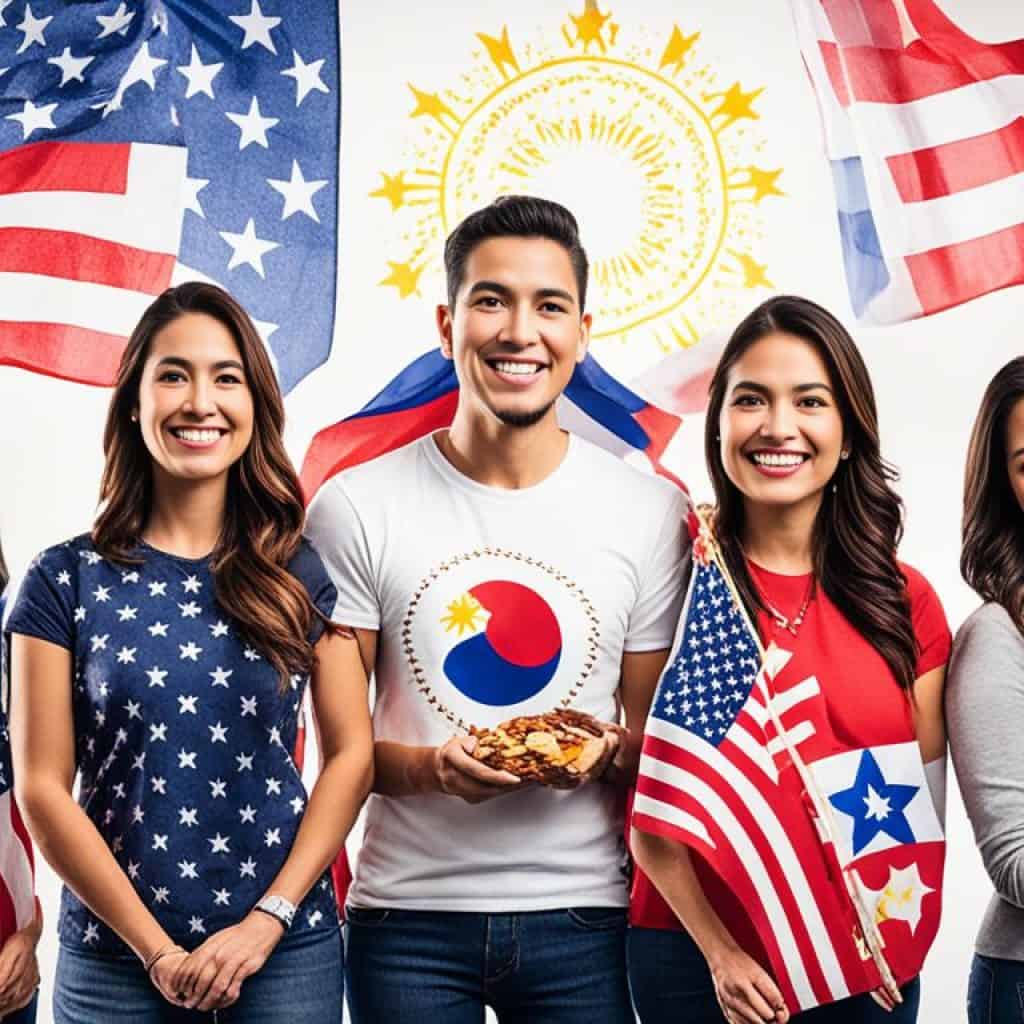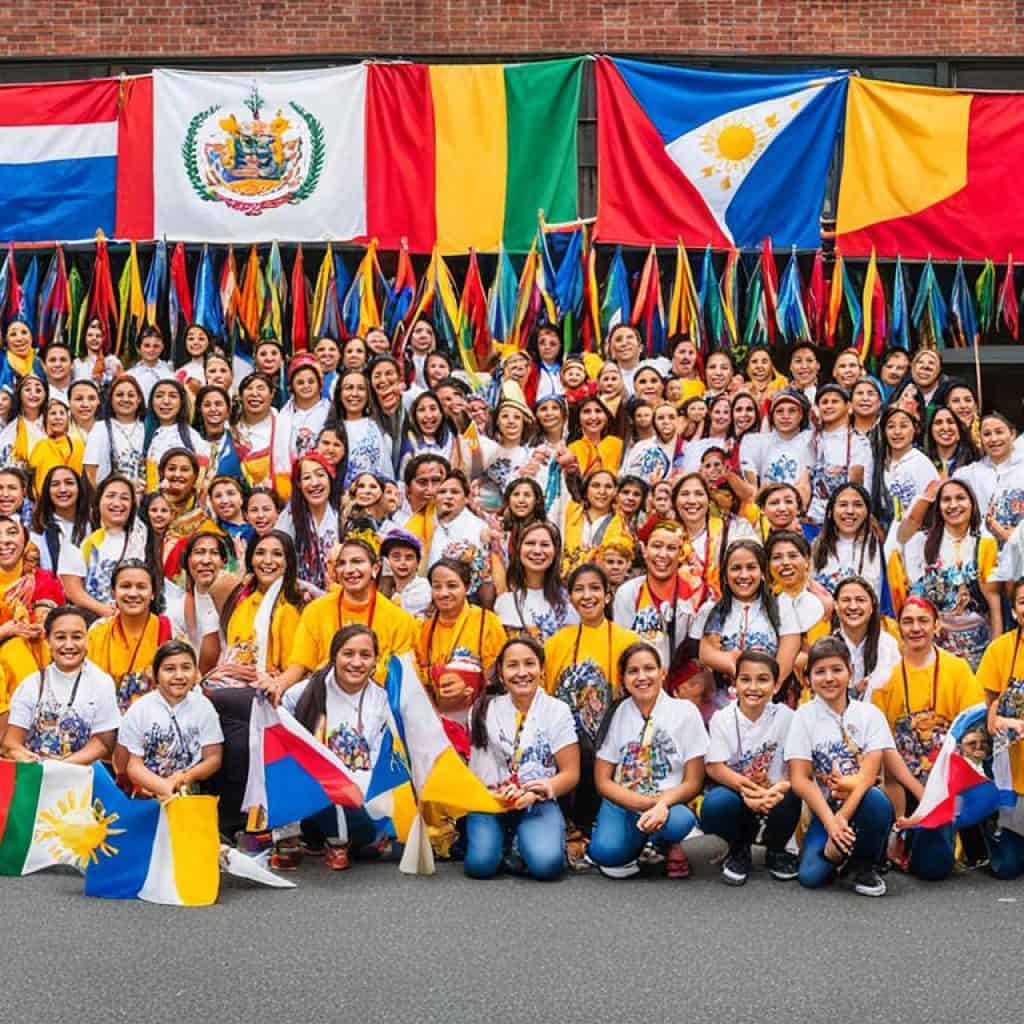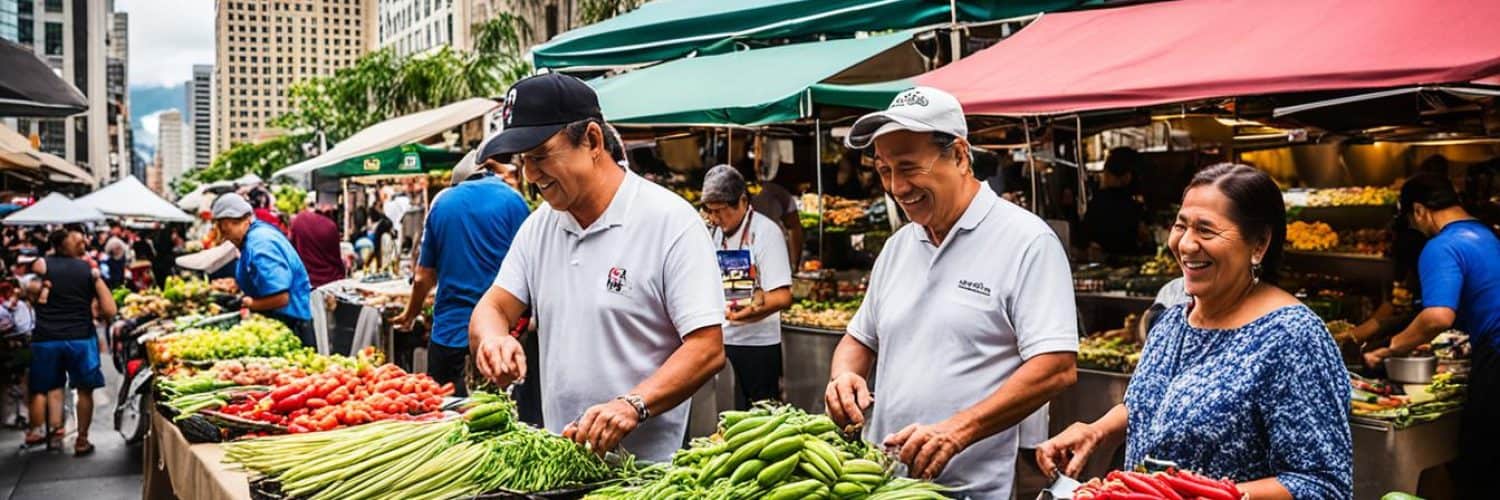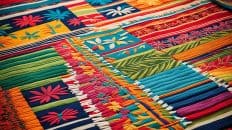Over 4 million Filipino Americans live in the United States. They bring their rich culture, arts, and cuisine. This has made a big impact on American society. Filipino culture is seen in festivals, museums, and community groups. It has become a key part of American diversity. Let’s take a closer look at Filipino culture and traditions in the US. We’ll discover the stories of the Filipino American community.
Key Takeaways:
- Filipino Americans have a strong cultural heritage that influences various aspects of American society.
- Filipino festivals and museums showcase the vibrant Filipino culture and traditions.
- The Filipino American community plays a vital role in preserving and promoting Filipino culture and values.
- Filipino Americans have a unique identity that combines their Filipino heritage with their American upbringing.
- Understanding the historical roots of Filipino immigration to the US is essential to appreciating the Filipino American community’s journey.
Filipino Festivals in the U.S.
Filipino festivals light up the U.S. with vibrant celebrations of culture and traditions. They let us see the beautiful customs, food, music, and dance of the Filipino community.
Across the country, many Filipino festivals bring people together:
- Fiesta in America in Secaucus, New Jersey
- Pistahan Festival in San Francisco, California
- FilAm Fest in San Diego, California
- Pagdiriwang Festival in Seattle, Washington
- Filipino Festival in Richmond, Virginia
- Filipino American Festival in Bergen County, New Jersey
At these events, you can enjoy tasty Filipino dishes, watch traditional dance and music shows, and join in cultural activities. It’s a chance for everyone to celebrate their heritage and connect with the Filipino American community.
“These festivals not only celebrate Filipino culture and traditions, but also serve as a bridge between generations, passing down the rich heritage and customs to future generations.”
These festivals offer a deep dive into the Filipino American culture for both Filipino Americans and those curious about it. They showcase the rich and varied traditions that are key to the Filipino American identity.
| Festival | Location |
|---|---|
| Fiesta in America | Secaucus, New Jersey |
| Pistahan Festival | San Francisco, California |
| FilAm Fest | San Diego, California |
| Pagdiriwang Festival | Seattle, Washington |
| Filipino Festival | Richmond, Virginia |
| Filipino American Festival | Bergen County, New Jersey |
Filipino American Museums
Discover the vibrant history and culture of Filipino Americans at museums across the U.S. These places celebrate the Filipino American community’s legacy. They let you see their lively heritage.
The Filipino American Museum in Stockton, California, is a key site. It gives a full view of their history, from the early days to now. The museum tells stories of their struggles and wins, showing their strong spirit and cultural impact.
Little Manila Rising is another must-see in Stockton, California. It tells the story of the “Little Manila” area, a key place for Filipino immigrants long ago. The exhibits show how this community helped shape a diverse America, highlighting their journey and dreams.
At these museums, you can see and do lots. They have hands-on displays, historical items, and photos. You can also learn through fun programs about Filipino traditions and their big role in America. These museums create an exciting and detailed experience for everyone.
Filipino American Community in the U.S.
The Filipino American community in the U.S. is vibrant and close-knit. They take great pride in their heritage and traditions. This group forms a strong sense of community, coming together in cultural and social organizations.
These communities are vital in keeping Filipino culture alive in the U.S. They organize activities and events that help Filipino Americans connect with their roots. These efforts foster a strong sense of identity.
Filipino American communities organize festivals, gatherings, and cultural performances. These events display the diversity and richness of Filipino culture. They feature traditional dances, music, and cuisine, allowing people to experience and appreciate Filipino heritage.
Filipino American Organizations
Many Filipino American organizations exist across the United States. They cater to the community’s needs and interests. These organizations provide support, resources, and services, fostering unity and belonging. They also offer social and cultural engagement opportunities, plus chances for personal and professional growth.
Prominent organizations include the Filipino American National Historical Society (FANHS), Association of Filipino American Teachers in America (AFAL), and Filipino American National Association (FANA). They play an active role in preserving Filipino culture and heritage. They also advocate for the rights and interests of Filipino Americans.
Filipino American Community Center
Community centers are often established by the Filipino American community in various U.S. cities. These centers serve as gathering spots, offering services and facilities. They may have meeting rooms, event spaces, classrooms, libraries, and recreational areas.
Community centers provide a space to connect and engage in cultural activities. They also serve as hubs for educational programs and workshops. These initiatives aim to preserve and promote Filipino culture within the community.
| Benefits of Filipino American Community | Examples |
|---|---|
| Preserving cultural traditions | Annual Barrio Fiesta in Los Angeles |
| Supporting community members | Bayanihan Foundation in Chicago |
| Providing educational opportunities | Filipino Educators of New York |
| Promoting cultural exchange | International Philippine Festival in Washington, D.C. |
| Fostering a sense of belonging | Bay Area Filipino Community Center |
The Filipino American community in the U.S. is growing and thriving. They make significant contributions to the cultural fabric of the country. Their dedication to preserving Filipino culture ensures that future generations will continue to celebrate their unique heritage.
Filipino American Identity
Filipino Americans blend their Filipino heritage with their American life. They grow up in the U.S. but keep ties to their Filipino roots. By combining both cultures, they form a special Filipino American identity. This identity mirrors their life, traditions, language, and customs. It adds to the vibrant Filipino American community.
They enjoy family gatherings with Filipino food and cultural events that highlight their heritage. Mixing Filipino and American ways creates a rich culture. This mix shapes their distinct identity.
Being bilingual, many Filipino Americans speak English and Tagalog or other Filipino languages. This helps them stay connected to their family and community. At the same time, they navigate American society.
Generational traditions and customs also build Filipino American identity. Celebrating holidays like Christmas, Easter, and Filipino festivals keeps their culture alive. It also shares it with younger generations. These customs connect them to their roots and strengthen their sense of identity.
“Being Filipino American means embracing the beauty of two worlds. Appreciating the values from our parents and ancestors while flourishing in American society.”
The Diversity within Filipino American Identity
Filipino American identity is diverse. The community includes various backgrounds and experiences. The Philippines is diverse too, affecting Filipino Americans.
Some are new to the U.S., bringing traditions and languages. Others are many generations in, shaped by their family’s history. Their experiences differ but all hold value.
There’s not just one Filipino American experience. Everyone has their own story, connecting to their Filipino heritage or blending it with American culture. This diversity strengthens the Filipino American community.
Preserving Filipino Culture and Heritage
The community values preserving Filipino culture. Cultural groups, centers, and schools help maintain this connection. They offer a space for Filipino Americans to connect and celebrate their heritage.
Through events, dance, and music, Filipino Americans keep their traditions alive. These activities boost pride in their heritage. They also connect them to their Filipino roots.

Filipino Americans enrich American society by holding onto their culture and identity. Their viewpoints, abilities, and traditions enhance the U.S.’s cultural diversity. It shows the importance of multiculturalism and embracing one’s heritage.
Historical Roots of Filipino Immigration to the U.S.
Filipinos started moving to the Americas in the 16th century. This has been a long history of Filipino migration. Yet, their stories and contributions often don’t get much attention in history books.
In the mid-1800s, Filipino immigration to the U.S. took a new turn. They set up permanent communities here. They came looking for jobs and a better life. Jobs were mainly in farming and fishing, especially in places like California and Hawaii.
But, the journey was tough for Filipino immigrants. They were often seen just as cheap workers, underpaid and working in bad conditions. The mistreatment they faced is a dark part of American history that we need to remember.
“We faced many hard times, both in body and heart, as we dealt with discrimination in the early days of Filipino immigration. We were seen as cheap workers or just oddities. But we didn’t give up. We stood up for ourselves and built communities that are strong to this day.”
Despite hard times, Filipino immigrants have done much for the United States. They were key in the farm labor rights movements. Figures like Larry Itliong and Philip Vera Cruz fought for justice and fairness.
Knowing this history helps us appreciate Filipino Americans’ strength and journey. Their stories make us think about American history more deeply. They challenge stereotypes and prejudices.
The Experiences of Early Filipino Immigrants
Early Filipino immigrants had a tough start in the United States. They faced discrimination and racism. They were often kept out of nicer neighborhoods and faced violence.
“Finding a place to live was hard. Many areas would not let Filipino people live there. We were stuck in places with few chances or help.”
But, Filipino Americans didn’t give up. They built communities and supported each other. They set up clubs and groups that gave them a sense of home.
Filipino Immigration during the 20th Century
In the 20th century, Filipino immigration changed a lot. When the Philippines became a U.S. territory in 1898, more Filipinos came to the United States. They were U.S. nationals and not limited by the same rules as other Asians.
But the Tydings-McDuffie Act in the 1930s changed things. It limited Filipino immigration as the Philippines moved towards independence. This made things harder for Filipino immigrants.
“New immigration laws made it harder for us. We had to deal with complicated rules and limits. This made reuniting with families or staying in the U.S. tough.”
Despite these hurdles, the Filipino American community kept growing. They adapted to changes while keeping their culture alive.
The Impact of Filipino Immigration
| Contributions | Impact |
|---|---|
| Community Building | Establishment of vibrant Filipino American communities, fostering a sense of belonging and support. |
| Advocacy | Leadership in civil rights and labor movements, fighting for justice and equality for all. |
| Cultural Enrichment | Introduction of Filipino culture, traditions, and cuisine to American society, contributing to the diverse tapestry of American culture. |
| Economic Contributions | Significant contributions to various industries, including agriculture, healthcare, education, and entrepreneurship. |
| Inspiration and Role Models | Inspiring future generations with the stories of their resilience, achievements, and contributions. |
The journey of Filipino immigration to the U.S. shows the strength of the Filipino American community. It also reminds us of our shared history. By understanding and valuing this history, we can work towards a future that’s fair and welcoming for everyone.
Filipino American Contributions
Filipino Americans have greatly impacted the United States across many areas. They’ve shown incredible talent and resilience. Their efforts have shaped the culture and society of America.
In music, film, and writing, Filipino Americans have shone brightly. Stars like Bruno Mars, Lea Salonga, and Jose Antonio Vargas are well-known. They’ve earned awards and made it easier for others to follow in their footsteps.
“When I think about the contributions of Filipino Americans, it’s hard to overlook the impact they’ve had in the arts. Our community takes pride in the accomplishments of Filipino American artists, who continue to inspire and uplift us through their work.” – Maria Santos, Filipino American historian
In science and tech, Filipino Americans have broken new ground. Dr. Fe del Mundo led advances in children’s health. The work of Dr. Edwin Catmull, co-founder of Pixar, changed the film and graphics world.
In politics and service, they’ve also stood out. Larry Itliong fought for workers in the farm labor movement. And in New York, Robert Ocampo was the first Filipino American elected to public office.
In sports, they’ve shown unmatched ability and hard work. Vicki Manalo Draves was the first Asian American woman to win Olympic gold in diving. Boxers like Ana Julaton and Nonito Donaire are celebrated worldwide.
Continuing the Legacy
These notable people are just a few examples of Filipino Americans’ vast contributions. They show the community’s resilience and talent. They also inspire future generations.
They’ve made a mark in the arts, science, politics, and sports. Their achievements highlight the rich Filipino culture and its impact on the U.S. They help keep the Filipino spirit alive and well.
By celebrating these achievements, we value the Filipino American community’s diversity and skills. Their success stories motivate us all to chase our dreams.
Filipino American Identity and Stereotypes
Filipino Americans have often faced stereotypes in the U.S. These stereotypes wrongly label them as either just cheap labor or successful “model minorities.” Yet, these views don’t show the Filipino American community’s true diversity and complexity.
Their identity blends Filipino heritage with American ways. It creates a mix of cultures, traditions, and values carried through generations. They live in two worlds, holding on to their Filipino roots and adapting to American life.
The community is diverse, with many backgrounds, experiences, and views. They enrich American culture with their talents, skills, and dreams.
It’s important to challenge these stereotypes to truly value Filipino Americans. Understanding their culture and heritage helps us see beyond stereotypes. This way, we get a fuller, more accurate view of this community.
“Filipino Americans have a rich and vibrant culture that goes beyond the limited scope of stereotypes.”
Breaking the Stereotype
Today, Filipino Americans are making their mark and speaking up in the U.S. They fight stereotypes by raising awareness, educating, and showing their true diversity.
They shine through cultural events and festivals. These are chances to share stories and feel proud of their heritage.
Working together within and beyond their community is key. This collaboration helps break down stereotypes and celebrate Filipino American identity.
Promoting Cultural Understanding
Education helps fight stereotypes and increases understanding of Filipino Americans. Schools and groups are starting to teach more about Filipino history and culture.
Filipino American artists and writers share their stories. Their work opens up discussions and celebrates their rich identity.
| Positive Contributions | False Stereotypes |
|---|---|
|
|
By challenging stereotypes, we can appreciate the Filipino American community better. Understanding them enriches American culture. It helps build a society that’s inclusive and fair for everyone.
The Filipino School of New York and New Jersey
The Filipino School of New York and New Jersey is all about promoting Filipino culture and education. It aims to keep Filipino heritage alive and supports Filipino Americans. The goal is to empower the next generation.
The school offers workshops and classes about Filipino history in America. They help students understand their immigration stories. It’s a place that helps students celebrate their heritage while facing new opportunities and challenges.
Students learn about their cultural roots in the workshops. They also feel proud of their Filipino identity. They discover the significant roles Filipino Americans have played in history.
The school acts as a bridge between generations. It ensures Filipino culture and traditions are passed down. This nurturing environment encourages open talks, builds community, and gives students a sense of belonging.
The Filipino School is making a big difference in the Filipino community. They promote cultural understanding and preserve Filipino heritage. Their work strengthens community bonds and enriches the Filipino American experience.
Preserving Filipino Identity and Empowering the Next Generation
“The Filipino School of New York and New Jersey is crucial for our community. It offers a safe place to learn about our heritage and connect. I’m thankful for the chance to grow as an individual and as a proud Filipino American.”
The Filipino School of New York and New Jersey has a lasting impact on Filipino Americans. Their commitment to culture, education, and the next generation is brightening the future of the Filipino community.

Filipino American Oral History Project
**
The Filipino American Oral History Project captures the stories of Filipino immigrants in America. It uses interviews to provide a space for them to share experiences. This project shows their impact on American society.
This project highlights Filipino Americans’ struggles, successes, and contributions. Their stories add to American culture’s richness. These tales bridge gaps across different generations in their community.
“We must remember that every individual’s journey is a piece of the greater puzzle of Filipino American history. Each story is a thread that weaves our cultural heritage into the fabric of America.” – Maria Santos, Project Coordinator
This project stands as a testament to the Filipino American community’s resilience and strength. Preserving these stories lets future generations learn and carry on their heritage with pride.
It also allows Filipino Americans to own their stories, breaking stereotypes. Their tales foster a deeper understanding of their culture. And they highlight their role in American history.
Preserving the Past, Shaping the Future
The project is crucial for both preserving the past and shaping the future. It documents Filipino Americans’ stories, contributing to their collective memory.
These stories reach a broader audience through exhibitions and educational programs. This fosters cultural appreciation. Researchers and scholars can delve into the Filipino American experience.
“The Filipino American Oral History Project is a living archive that allows us to grasp the depth and significance of our community’s contributions. It empowers future generations to embrace their cultural heritage and continue the legacy of resilience and achievement.” – Dr. Carlos Rodriguez, Historian
Preserving Stories, Connecting Communities
The project connects Filipino Americans across places and generations. It fosters community and belonging through shared experiences.
Oral histories and community events encourage dialogue and reflection. This builds a strong sense of identity, pride, and unity.
By sharing these narratives, the project keeps future generations tied to their roots. It helps them celebrate their Filipino heritage.
Sharing The Filipino American Journey – Table of Contents
| Chapter | Topic |
|---|---|
| 1 | Early Immigration and Settlement |
| 2 | Struggles and Triumphs |
| 3 | Contributions to American Society |
| 4 | Cultural Preservation and Identity |
| 5 | Resilience and the Power of Community |
Each chapter delves into specific aspects of the Filipino American journey. It explores the challenges, achievements, and cultural importance. These stories showcase the Filipino American community’s strength.
Join us as we rediscover, celebrate, and preserve the Filipino American experience through storytelling!
Filipino American Literature and Film
Filipino American literature and film are important for exploring the richness of Filipino culture. They celebrate identity and experiences in the U.S. They let Filipino Americans share their stories.
This helps everyone understand the Filipino American experience. It builds cultural appreciation.
Reading Filipino American literature lets us dive into a world of diverse experiences. Books like Carlos Bulosan’s “America Is in the Heart” are insightful. And Jessica Hagedorn’s “Dogeaters” shows the life of Filipino Americans.
These books talk about the struggles and victories of being Filipino American. They explore cultural mixing, facing discrimination, and the quest to belong.
Filipino American films bring stories to life visually. They explore important themes. Movies like “The Debut” and H.P. Mendoza’s “Colma: The Musical” are good examples.
They show life through a Filipino American lens. Topics like family, tradition, and finding oneself are common.
These works represent Filipino Americans in arts. They add to American literature and cinema. They offer new views and start conversations about Filipino American life.
“Filipino American literature and film show our heritage and individual stories. They help us connect with our roots and celebrate our culture.”– [Author Name]
Filipino American Organizations and Communities
Filipino American organizations and communities are key to creating a strong sense of belonging. They offer resources and opportunities to empower individuals. These efforts strengthen the bonds within the community.
Support and Resources
**Filipino American organizations** provide crucial support tailored to community needs. They help with healthcare navigation and language translation. They also collaborate with local businesses to help the community grow and prosper.
Cultural Celebrations and Events
These organizations are committed to celebrating **Filipino culture and heritage**. They organize cultural events, festivals, and gatherings. These events feature traditional Filipino dances, music, and cuisine, highlighting the rich Filipino heritage.
Advocacy and Awareness
Filipino American groups work to improve Filipino Americans’ lives. They raise awareness on immigration, labor rights, and social justice. Their advocacy efforts aim at creating a more inclusive society.
Building Stronger Connections
These organizations bring Filipino Americans closer, fostering unity. They offer platforms for sharing experiences and making friends. **Filipino American communities** provide a supportive space for expressing cultural heritage.
Through their efforts, they promote the **filipino American** identity and preserve **filipino culture**. They play a significant role in empowering the community.
Filipino Cuisine in the U.S.
Filipino cuisine in the U.S. has gained popularity, attracting food lovers with its unique tastes. It offers a variety from savory to sweet, showcasing the Philippines’ rich culinary tradition.
Across the U.S., Filipino restaurants provide an authentic taste of their cuisine. These spots are popular among Filipino Americans and those eager to explore Filipino food.
Adobo, sinigang, and pancit are favorites in these eateries. Adobo features marinated meat in a vinegar and soy sauce blend. Sinigang is a sour soup that balances Filipino flavors perfectly. Pancit highlights the Chinese influence on Filipino cuisine, with its varied noodle styles.
“Filipino cuisine is a vibrant mix of flavors, shaped by different cultures and regional diversity. It’s the essence of Filipino culture and heritage.”
Trying Filipino food is more than enjoying good meals. It connects you to the rich culture and history of the Philippines. Every dish has a story, filled with traditions from past generations. It’s a way into the Filipino lifestyle and the values they hold dear.
The Uniqueness of Filipino Cuisine
Filipino cuisine stands out with its imaginative use of ingredients. The mix of sweet, sour, salty, and savory notes creates a unique taste. Elements like coconut milk and calamansi add complexity, making Filipino dishes special.
The Role of Filipino Food in Cultural Celebrations
Filipino food is crucial in cultural celebrations, symbolizing unity and happiness. It stars in important events like birthdays and weddings. Food brings people together, creating shared moments of joy.
Popular Filipino Dishes
| Dish | Description |
|---|---|
| Adobo | A marinated meat dish stewed in vinegar, soy sauce, garlic, and spices. |
| Sinigang | A sour soup made with tamarind and various vegetables. |
| Pancit | A noodle dish with regional variations, often served during celebrations. |
| Lechon | A whole roasted pig, often the star of festive occasions. |
| Kare-Kare | A rich peanut-based stew made with oxtail, tripe, or vegetables. |
Enjoying these famous Filipino dishes does more than fill you up. It lets you dive into the vibrant Filipino culture and heritage that enriches America’s food scene.
Filipino American Artists and Performers
Filipino American artists and performers share their amazing talents in many arts forms. They highlight the Filipino American community’s creativity and spirit. From winning Grammy awards to showcasing talent in dance, art, and theater, they play a huge role. They help promote Filipino culture and heritage in the U.S.
Music
In music, Filipino American artists shine across different styles. Take Bruno Mars, an award-winning artist with Filipino roots. His background influences his music, making him a big name in music. Others like H.E.R., Apl.de.ap of The Black Eyed Peas, and Arnel Pineda of Journey also stand out with their talents.
Dance
Filipino American dancers impress with their beautiful moves and cultural acts. Stella Abrera marked history as the first Filipino American principal in the American Ballet Theatre. The Jabbawockeez, a hip-hop dance crew, wowed everyone on “America’s Best Dance Crew.” They’ve brought Filipino American dance to the limelight with their amazing performances.
Visual Arts
In the art scene, Filipino American artists leave their mark with unique works. Artists like Pacita Abad are known for colorful and meaningful paintings. She tackled themes like social justice and Filipino identity through her art. Young artists such as Nica Aquino and Patrick Martinez continue to impress with their beautiful and thought-provoking pieces.
Theater
The theater world has seen great Filipino American talents too. Lea Salonga won a Tony for her role in “Miss Saigon.” She also sang for Disney’s Jasmine and Mulan. Stars like Darren Criss of “Glee” and playwright Lauren Yee show the wide range of Filipino American talent in theater.
The work of Filipino American artists and performers puts Filipino culture in the spotlight. They show off their talents, creativity, and unique views, entertaining and teaching others. They help people appreciate culture and understand more, connecting Filipino and American identities.
Conclusion
Filipino culture thrives in the United States, becoming a key part of American life. The Filipino American community contributes greatly to America’s cultural mix with its rich heritage. By celebrating and exploring Filipino culture, we learn to appreciate the diversity in the U.S.
Filipino Americans are known for their close relationships and support for each other. They gather in groups to keep their traditions alive. This helps maintain their identity and creates a welcoming space for everyone.
In balancing two cultures, Filipino Americans create a unique identity for themselves. This identity reflects their journey, traditions, and contributions to American society. Celebrating Filipino culture helps make the U.S. more inclusive and diverse.







Add comment